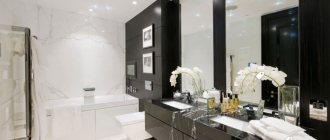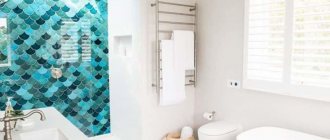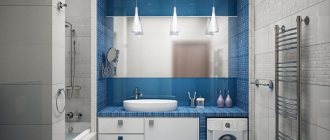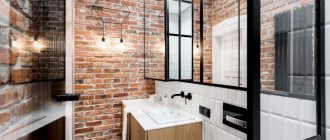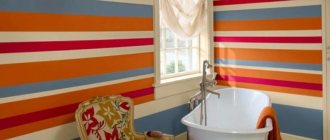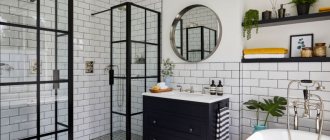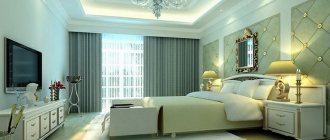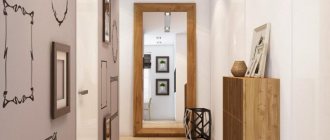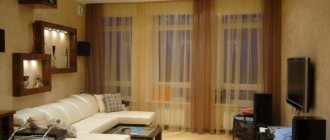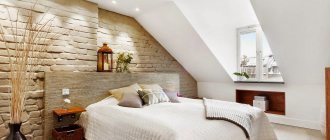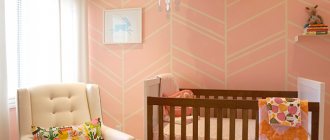Almost every modern bathroom has a shower. This is especially true for very small rooms, where there is simply nowhere to install a bathtub. But, if you have a large enough room, you can easily place both a shower and a bath there. With their help, water procedures will become more pleasant and faster. If you are planning a renovation in the near future, then it is worth considering a special finish for the space near the shower. After all, temperature changes occur here every day and high humidity reigns. And the surface of the shower stall requires frequent washing and cleaning. Therefore, it is important to think about what kind of finishing material you would like to see in your bathroom.
Ceramic tile
This material can rightfully be considered one of the most popular. The advantages of its use include: strength, durability, moisture and heat resistance, ease of maintenance, a larger selection of colors, and a fairly inexpensive cost. But the material also has its drawbacks. This is both the complexity of installation and the need for special care for the seams between the tiles. If the bathroom decoration is made entirely of ceramic tiles, then the interior can be quite cold. Most often, ceramic tiles have a rectangular shape. If desired, you can choose a matte or glossy surface of the material. When tiling, the grout can be chosen to match the tone of the tiles, or you can give preference to contrasting combinations. With its appearance, ceramic tiles can replicate various surfaces - stone, wood and others. If you choose this finishing material, you can create any interior with your favorite color and texture.
The surface of ceramic tiles does not require special care. You just need to periodically clean the tiles using store-bought detergents. Unfortunately, dust, dirt and various microbes quite often collect in the seams between ceramic tile elements. It is necessary to clean the grout from time to time, and also be sure to treat it with an antiseptic.
Color scheme for a bathroom with shower
The color scheme for a bathroom with a shower directly depends on its area and the amount of light. The simplest solution is all shades of white, beige and gray, which go well with any collection of sanitary ware. Black interiors with matte black trays, sinks and toilets look fresh and modern.
To make a room brighter and lighter, use shades of yellow: from pale vanilla to deep mustard or acidic lemon. Blue, blue and mint tones give a feeling of lightness and coolness. Shades of red and orange are invigorating, purple stimulates the imagination, and brown looks classically reliable.
Modern bathrooms have a lot of chrome, mirrors and glass in furniture, fixtures and fittings. In aged, vintage and loft interiors, brass, gilding, aged silver and bronze are good.
Design of a small bathroom (90 photos)
Making a choice in favor of mosaics
Mosaic is a fairly ancient material. This is a great way to finish a variety of surfaces. Mosaic can be very different. It will help transform the interior of any bathroom. Thanks to the wide variety of colors and shapes, you can create a unique interior and even real panels. It is great for dividing space into functional zones and finishing individual parts of the room. Mosaic adheres perfectly to any surface. With its help you can veneer surfaces of any complexity. The durability of the material should also be noted separately. Installation of such tiles does not require detailed adherence to the image, so with its help you can achieve a unique pattern on the wall surface. This material has only two small drawbacks: the high price of the material itself, as well as the cost of installation services.
Plumbing
The practicality and convenience of a bathroom directly depends on the choice of plumbing fixtures. If you have a combined bathroom, in addition to the shower stall itself, you need to select a toilet and a sink. And in such a way that they are combined with each other and do not take up too much space.
Shower cabin
All shower cabins are divided into open or closed, depending on the presence of a top. They consist of a pallet and partitions, and compact corner models are partially adjacent directly to the wall. Open booths are cheaper and easier to install, while massive closed ones have more options built into them and are hygienic.
Shower trays can be square, rectangular, triangular or rounded. Some models provide additional hooks, shelves, fastenings and mirrors. Hinged or sliding doors are most often made of glass or acrylic, with airtight seals along the edges and at the joints.
Sink
Bathroom sinks differ in the installation method and the shape of the bowl, depending on which you can change the location. The most popular are square, rectangular and oval models. Corner sinks are good for small bathrooms, and for designer interiors you can have an unusual custom-made shape.
Wall-hung sinks are installed close to the wall on brackets, leaving space underneath for baskets, shelves or other small items. Tulips are distinguished by the presence of a central support and bulkiness, but they are more convenient in rooms where the water supply and drainage do not come from the wall, but from the floor. Built-in bowls are mounted directly into the furniture: fully or partially protruding above the surface.
Toilet
Modern toilets differ in the installation method and are classified into floor-mounted and wall-hung. The former are cheaper and easier to install, but they take up more space and are suitable for spacious bathrooms. Anchor bolts are used for installation and this can be done without damaging the floor or wall covering.
A more modern and ergonomic solution is corner floor models or toilets with installation. The drainage system is retracted behind the wall and does not take up space, unlike a separate tank or monoblock. The hidden design is installed on the frame and hidden behind a partition or cabinet door.
Wall-hung toilets are the smallest and most compact, but can easily withstand high loads. In addition to saving space, they make cleaning much easier, so it's also more hygienic. But installation also requires the installation of a false wall and frame.
Bathroom interior design: 80 photo ideas
Porcelain tiles
Porcelain tiles are very similar to ceramic tiles. It is strong and durable. Most often, this material is used for finishing the floor, but quite often it can be found on the walls. The pros and cons of this material are absolutely identical to the properties of ceramic tiles, but there are also some peculiarities. Porcelain tiles are absolutely not afraid of impacts and cracks from heavy objects.
Modern stores offer a wide selection of porcelain tiles of any color, pattern and texture. If you want to create an interesting bathroom interior, you should pay attention to the combination of light plaster with moisture-resistant properties and porcelain stoneware. Caring for porcelain tiles is quite simple. It is necessary to acquire cleaning products that can be found in any store. But you should be extremely careful with the seams between the tiles. It is imperative to clean and treat the seams. To care for them you will also need antiseptics.
Choosing a color
Due to the fact that a bathroom with an area of 6 square meters is considered quite spacious, the finishing can be done in any color you like:
- Light shades create a cozy and calm atmosphere in the house. Many people do not like white because it is “sterile” and because it resembles the walls of an operating room or treatment room. In this case, it is quite possible to use all shades of beige or any other pastel colors. Finishing in light colors is good because it matches with any plumbing fixtures and furniture;
- the use of blue and blue colors in the bathroom interior is fully justified by the fact that the water element is dominant here. The main thing is not to overdo it with decor in the form of shells and images of sea creatures. The most advantageous option for a “marine” finish is blue mosaic in combination with white sanitary ware;
- The classic combination of black and white looks strict but aesthetically pleasing. Typically, walls and ceilings are finished in white and floors in black, which creates a visual increase in the volume of the room. If you use black and white ceramic tiles for horizontal and vertical surfaces, the boundaries between the walls and floor will be erased. White plumbing and black doors will perfectly complement the interior;
- finishing a shower in dark colors is a rarity due to the fact that such colors visually reduce the area of the bathroom in the house. Also, dark walls and floors require maintenance, as any dirt and splashes are very visible on them.
Bathroom in blue tones
Bathroom in black and white colors
Light colors in the design of a small bathroom
When choosing a finishing color, give preference to neutral tones; bright colors quickly become boring.
Marble finish
Natural stone is the strongest and most durable finishing material. One of the best is considered a beautiful stone - marble. It will add sophistication, elegance and a rich look to any interior. This material has many advantages. But the disadvantages can easily be attributed to the very high cost (of natural stone). It is best to use marble tiles in places where there is high humidity - the apron above the washbasin, the surface of the shower and bathtub. Marble is often used for flooring. It has incredible strength and durability. Even if sharp and heavy objects fall, the integrity of the material will not be compromised. But microscratches may well form. But it is quite possible to polish the marble and rub it with special wax. The durability of marble cladding is both an advantage and a disadvantage. A marble interior can be passed down from generation to generation. But some people like it, while others may simply get tired of such an interior. Therefore, if you know that you may get tired of such cladding after 5-10 years, then it is better to pay attention to artificial stone.
Design of a small bathroom with shower
For small bathrooms, shower cabins are a real find, especially corner ones. Massive closed structures with all four walls are not suitable because they take up too much space. But partitions that are adjacent directly to the wall will be just right.
Some of the shelves and hooks for bath accessories can be moved inside the shower room. This means saving space outside so that the small bath is less cluttered. Hide household chemicals in a cabinet behind the installation, and install the sink on a cabinet or combine it with a washing machine.
Design of a narrow bathroom: 65 photos of beautiful solutions
Use of decorative plaster
In such a room, decorative plaster is used quite rarely. This finishing method involves covering the walls using moisture-resistant plaster. You can completely decorate the walls yourself. The material itself is quite inexpensive, so if you want to quickly and inexpensively change your surroundings, you can afford it at any time. But this finish also has its drawbacks. The material's properties are quite short-lived and very sensitive to temperature changes. In addition, there is a high probability of condensation accumulating on the surface. Wall decoration with textured plaster involves the use of plain options. If you want to diversify your interior, you can use LED lighting.
Secrets of creating a beautiful interior
If you want to visually enlarge the room, use the following features in the interior:
- more glossy surfaces. This applies not only to walls and ceilings, but also to plumbing fixtures and furniture;
- transparent doors on the cabinets on the front side of the shower;
- minimum dimensions of plumbing fixtures. For the toilet, sink, bidet, use installations;
- hanging and built-in cabinets located under or above the sink, as well as above the washing machine, toilet;
- diagonal pattern on tiles. It is not necessary to choose a tile with a pattern; it is enough to lay it diagonally, which also expands the space;
- bright lighting. If there are no dark corners in your shower room, it will appear much larger.
Using these little tricks, you will create a stylish shower room interior in your home.
Arrangement of a shower room in an unusual place
Quite often, owners who have attic or attic space at their disposal use this space to furnish a bathroom. If the room has a strong sloping ceiling, then it is best to locate the shower in the place where the ceiling has the greatest height. The rest of the space can be used to install all the other necessary items for the bathroom.
To design a shower room, you can use a combination of different claddings. For symmetrical surfaces, you can use porcelain stoneware or ceramic tiles, and for surfaces with a large slope - mosaic. As for color design, for small rooms it is best to use a light palette. With the help of a snow-white finish you can visually expand a modest space. You can use the method of contrasting combinations. A black and white color scheme will look appropriate.
Design style
When decorating a shower room measuring 6 square meters, you can use different styles and interior design options. The most current styles are minimalism, hi-tech or modern, because most shower cabins look ultra-modern. But if you wish, you can bring any idea to life:
- rustic country style or chalet with wood finish - a suitable interior for a private home;
- decoration in Provence style will create a cozy romantic atmosphere;
- The loft style is somewhat reminiscent of modern high-tech and involves partially decorating the interior as an industrial space.
Country style shower room
Shower room in loft style
Decorating a shower room in the Provence style
It is better not to use styles such as classic, empire, baroque or art deco, since creating such an interior requires a large area. Even in a private house with a shower room of 6 square meters, a classic finish requires a bathtub, as well as a large room size. In a small shower room, rich classic finishes look unpresentable.
Waterproof paint
- the most economical and simple option;
- plenty of room for experimenting with color;
- strict adherence to hygiene standards.
Of course, not every paint will find its ideal application on the walls of your bathroom. You should focus on waterproof options based on latex or acrylic. As a rule, they contain active substances that prevent the formation of mold and mildew. True, areas that have direct contact with water - for example, in the shower area, washbasin - are best covered with tempered glass.
- fragility;
- Over time, even the brightest color fades;
- If the base is not properly prepared, the paint may peel off and fall off.
What are the nuances?
Perhaps, here we should talk about the most important and only nuance - the need for high-quality primer of the wall surface. Choose a water-repellent primer with deep penetration - and be sure to carefully treat the grooves with it - very often they become the source of the spread of various “infections” (how to properly groove walls). In general, the scheme of actions is extremely clear:
- first primer;
- and only then painting.
Several photos where the owners chose ordinary waterproof paint for wall decoration, as well as a water-based paint consumption calculator.
Lining
- pleasant relief;
- basic installation;
- unpretentious care.
It should be clarified right away: you can only use either plastic lining or its version made of moisture-resistant MDF in a bathroom format. In the second case, the material is reliably treated with antiseptics and does an excellent job of protecting against constant exposure to water flows. But - for the time being.
We invite you to familiarize yourself with: Hollow concrete blocks: for walls, foundations, fences
Fragility is the main disadvantage of lining. Over time, even the most durable MDF swells and loses all its attractive qualities. In order to delay this moment, owners often coat the lining with varnish. This allows the material to acquire additional decorative value by playing with reflections of light.
The lining also helps to visually enlarge the room. To do this, you need to attach it to the wall vertically. In general, this finishing option is most often typical for private houses - in the format of multi-apartment buildings, people prefer other options for decorating walls.
If you decide to focus on this particular material, then this instructional article will help you: ”
White classic
White classic
Most often, white cladding is used in bathrooms; it can safely be considered classic. It is suitable for spaces in Scandinavian and modern, as well as in the high-tech direction. For variety, it’s worth trying not just white tiles; options with additional laconic decor will look much more interesting.
White tiles with a pattern
Warm atmosphere
Warm atmosphere
To create a warm and cozy atmosphere in the shower, you should use materials that imitate natural wood. Thanks to the wide variety of facing materials, this is not difficult to do. In such a shower, elements made of brass and copper would be appropriate.
Wood look tiles
We suggest you familiarize yourself with: Floating screed floor on the ground. The floor in the house is on a strip foundation. What not to do
No. 7. A natural stone
This is one of the most expensive, but undoubtedly effective solutions. Marble is often used when decorating walls - it is one of the safest natural stones that does not accumulate high levels of radiation. In addition, marble has a low moisture absorption coefficient, and its porous structure allows the material to “breathe” and thereby regulate the microclimate in the room.
But a material like marble also has some disadvantages. Firstly, it is very expensive, secondly, it requires constant careful care, and thirdly, this material does not resist acid-containing products well, so care becomes even more difficult. In addition, it is quite heavy material.
limestone, sandstone, slate, granite and cobblestone are actively used for wall cladding
Dark haze
Dark haze
It is much less common to find dark cladding in bathrooms, but it looks no less attractive than light cladding. Black is best used to highlight an accent wall or niche. It is also useful for blurring the boundaries of space, for example, to visually raise a low ceiling. This can be achieved if you decorate the entire space with light tiles, and highlight the middle of the wall with a dark stripe that will extend onto both the floor and the ceiling.
Dark shower lining
Interesting shower cladding
Creative cladding
